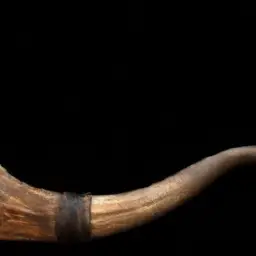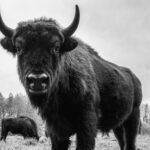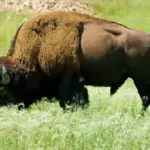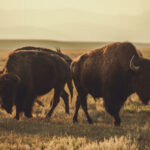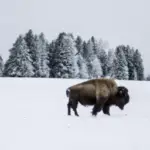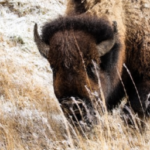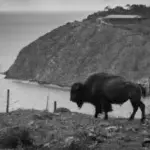Imagine a world without bison. Picture the vast grasslands, once teeming with these majestic creatures, now barren and silent. The impact of their absence would ripple through the ecosystem, affecting not just the plants and animals that depend on them, but also the delicate balance of nature itself. In this article, we explore the far-reaching consequences of a world without bison, shedding light on the crucial role these creatures play in shaping the landscape and maintaining biodiversity. Discover the hidden intricacies of the bison’s impact and gain a deeper understanding of the importance of preserving these magnificent animals for generations to come.
Ecological Impact of Bison Extinction
Loss of Bison’s Role as a Keystone Species
The ecological impact of bison extinction would be substantial. As a keystone species, bison play a crucial role in maintaining the balance of their ecosystem. Their grazing behavior shapes the structure of the grasslands, promoting the growth of diverse plant species. Without bison, the grasslands could become dominated by certain plant species, leading to a loss of habitat for other organisms and a decline in overall biodiversity.
Decrease in Biodiversity
The extinction of bison would result in a significant decrease in biodiversity. These large mammals provide habitats for a variety of wildlife, both directly and indirectly. Their wallows and grazing patterns create diverse microhabitats for insects, birds, and small mammals. Additionally, the grazing and trampling activities of bison create openings in the vegetation, allowing for the growth of different plant species. Without the presence of bison, the ecosystem would become less dynamic and diverse, leading to a decline in overall biodiversity.
Disruption in Food Chains
Bison play a critical role in the food chains of their ecosystem. They are a primary food source for many predators, including wolves and bears. The loss of bison would result in a disruption of these predator-prey dynamics, as predators would have to seek alternative food sources or face population declines. Additionally, scavenger species, such as vultures and coyotes, rely on carcasses left behind by bison for sustenance. Without bison, these scavenger species would have to find alternative food sources, potentially leading to imbalances in the ecosystem.
Effects on Other Species
Impact on Predators
The disappearance of bison would have a significant impact on predator populations. Wolves, for example, rely heavily on bison as their primary prey. The loss of this food source could lead to declines in wolf populations, as they would have to search for alternative prey or face competition with other predators for limited resources. This ripple effect would disrupt the balance of predator-prey relationships in the ecosystem, potentially leading to cascading effects throughout the food web.
Impact on Scavenger Species
Scavenger species, such as vultures and coyotes, heavily depend on the carcasses left behind by bison. These carcasses provide an important food source for scavengers, allowing them to survive and maintain their populations. Without bison, scavenger species would face a scarcity of food, potentially leading to declines in their populations and imbalances in the ecosystem. This loss of scavenger species could also have indirect effects on other organisms that rely on them for various ecological services, such as carcass removal and nutrient cycling.
Effects on Broader Ecosystem
The extinction of bison would have far-reaching effects on the broader ecosystem. Their significant influence on grazing behavior and trampling activities shapes the landscape and vegetation patterns. Bison help maintain grassland ecosystems by promoting the growth of diverse plant species and preventing the dominance of certain plants. Their absence could lead to changes in vegetation composition, potentially favoring invasive species and altering the overall structure and function of the ecosystem. These changes could have cascading effects on other organisms and disrupt the complex interactions within the ecosystem.
Impact on Soil and Plant Health
Role of Bison in Soil Aeration
Bison play a vital role in soil aeration through their grazing and trampling activities. As they move across the land, their hooves break up the compacted soil, allowing for better oxygen and water infiltration. This promotes the health of soil microorganisms and contributes to the overall fertility and productivity of the soil. Without bison, the soil could become compacted, leading to reduced soil health and nutrient cycling, which would have negative consequences for plant growth and overall ecosystem functioning.
Effects on Plant Growth and Seed Dispersal
The grazing behavior of bison has a significant impact on plant growth and seed dispersal. Bison selectively graze on certain plant species, creating openings in the vegetation for the growth of other plant species. This promotes plant diversity and helps maintain a balance of different plant communities. Bison also aid in seed dispersal through their consumption of plants and subsequent dispersal of seeds through their feces. The absence of bison would disrupt these processes, potentially leading to a decline in plant diversity and altered vegetation patterns.
Changes in Landscape
The extinction of bison would bring about noticeable changes in the landscape. The grazing and trampling activities of bison shape the physical structure of the grasslands, creating a mosaic of different habitats. Their presence helps maintain the open nature of grassland ecosystems, preventing the encroachment of shrubs and trees. Without bison, the grasslands could become denser and more dominated by woody vegetation, altering the overall appearance and function of the landscape. These changes could have cascading effects on other organisms that rely on the specific habitat characteristics provided by bison.
Consequences for Water Systems
Alteration in Water Filtration
Bison play a crucial role in water filtration processes within their ecosystems. Their grazing behavior helps maintain the integrity of wetland areas and prevents sedimentation in streams and rivers. By keeping the vegetation in check, bison minimize erosion and maintain water quality. The loss of bison could result in increased sedimentation and reduced water filtration capacity, compromising the health and functionality of aquatic ecosystems.
Impact on Aquatic Ecosystems
The extinction of bison would have a direct impact on aquatic ecosystems. Wetland areas, which are vital for many aquatic species, depend on the grazing activities of bison to prevent excessive vegetation growth. Bison trampling and grazing contribute to maintaining open water areas and creating diverse habitat conditions for aquatic organisms. Without bison, wetland ecosystems could become overgrown and lose their ecological integrity, leading to a decline in aquatic species diversity and overall ecosystem health.
Possible Changes in Water Table Levels
The disappearance of bison could potentially result in changes in water table levels. Bison significantly influence the water cycle through their grazing and trampling activities, which can alter vegetation patterns and water retention in the soil. Without bison, water table levels could be affected, potentially leading to reduced water availability for both aquatic and terrestrial organisms. These changes in water availability could have cascading effects on the overall functioning of the ecosystem and its inhabitants.
Implications for Climate Change
Bison’s Role in Carbon Sequestration
Bison play a role in carbon sequestration, which is crucial in mitigating climate change. The grazing behavior of bison helps maintain grasslands’ productivity and carbon storage capacity. As they consume plant material, they stimulate new growth, which promotes carbon uptake from the atmosphere. Additionally, their trampling activities facilitate the incorporation of organic matter into the soil, enhancing carbon sequestration. The extinction of bison would reduce this carbon sequestration potential and could result in increased greenhouse gas emissions.
Potential Increase in Greenhouse Gas Emissions
The extinction of bison could lead to increased greenhouse gas emissions. By reducing carbon sequestration in grassland ecosystems, the absence of bison would contribute to higher levels of carbon dioxide in the atmosphere. Additionally, changes in vegetation composition due to the loss of bison could result in altered fire regimes, potentially releasing stored carbon into the atmosphere. These increased emissions of greenhouse gases would further contribute to climate change and its associated impacts.
Increased Vulnerability of Ecosystems to Climate Change
The loss of bison would make ecosystems more vulnerable to climate change. Bison contribute to the resilience of ecosystems by promoting biodiversity, maintaining vegetation structure, and enhancing carbon sequestration capacity. Their absence could disrupt these important processes, making ecosystems less able to cope with the impacts of climate change, such as increased temperatures, altered precipitation patterns, and extreme weather events. The loss of bison would therefore exacerbate the challenges faced by ecosystems in adapting to changing environmental conditions.
Socioeconomic Impact
Impact on Bison Meat and Hide Industries
The extinction of bison would have significant implications for industries that rely on bison meat and hides. The loss of the bison population would result in a scarcity of these resources, potentially leading to increased prices and limited availability. Bison ranching and farming industries would also face significant challenges, as their primary source of reproductive stock and genetic diversity would be lost. This could have economic repercussions for these industries, affecting livelihoods and resulting in job losses.
Effects on Ecotourism
Bison are a major attraction for ecotourism, drawing visitors from around the world to observe and appreciate these iconic animals in their natural habitat. The extinction of bison would greatly impact ecotourism, leading to a decline in visitors to regions where bison once roamed. This decrease in tourism revenue could have negative economic consequences for local communities and businesses that rely on ecotourism as a source of income.
Potential Job Losses
The extinction of bison would potentially lead to job losses in industries and sectors that directly or indirectly depend on bison. This includes bison meat and hide industries, tourism and hospitality sectors, and conservation and research organizations focused on bison conservation. The loss of these employment opportunities would have social and economic implications, affecting the livelihoods of individuals and communities that depend on these industries for income and stability.
Impact on Cultural and Spiritual Practices
Significance of Bison in Native American Culture
Bison hold great cultural and spiritual significance for many Native American tribes. They are considered a sacred and revered animal, and their presence is deeply woven into the cultural traditions and practices of these communities. The extinction of bison would result in the loss of an important cultural symbol and disrupt traditional ways of life. Native American tribes would lose a crucial element of their cultural heritage and face challenges in preserving their customs and spiritual practices.
Impacts on Art, Myths, and Rituals
Bison are often depicted in various forms of art, including paintings, sculptures, and traditional crafts. They also feature prominently in myths, legends, and rituals of different cultures and communities. The loss of bison would impact the artistic expression and storytelling traditions associated with these magnificent animals. Artists would lose an important subject matter, and cultural practices that incorporate bison would face significant changes, potentially affecting the richness and diversity of cultural heritage.
Loss of Cultural Heritage
The extinction of bison would represent a loss of cultural heritage for societies and communities that have historically coexisted with these animals. Bison are deeply intertwined with the identity and history of many groups, and their disappearance would result in the erosion of cultural knowledge and practices. Preserving and protecting the bison not only ensures the survival of the species but also safeguards the cultural heritage and traditions associated with them.
Health and Nutritional Ramifications
Loss of Bison as a Sustainable Protein Source
Bison meat has gained recognition for its nutritional benefits and sustainability compared to traditional livestock. Bison meat is lean, rich in nutrients, and generally raised without the use of hormones or antibiotics. The extinction of bison would result in the loss of this sustainable protein source, potentially reducing the availability of a healthy and environmentally friendly meat option for consumers. This could have implications for individuals and communities who rely on bison as a source of nourishment.
Effects on Human Health
The extinction of bison could have various effects on human health. Bison meat is a valuable source of lean protein, essential fatty acids, and important micronutrients. Its removal from the food system could lead to dietary changes for communities that traditionally consume bison, potentially affecting the nutritional balance and overall health of individuals. Additionally, the loss of the environmental services provided by bison, such as carbon sequestration and water filtration, could have indirect impacts on human health through the alteration of ecosystem dynamics.
Changes in Food Systems
The extinction of bison would necessitate changes in food systems, particularly for communities that rely on bison as a staple food source. These changes could involve the adoption of alternative protein sources, potentially leading to shifts in dietary patterns and availability. The loss of bison as a sustainable and culturally significant food source would not only impact the individuals directly dependent on these animals but also shape the broader food systems and consumption patterns of regions where bison once thrived.
Biodiversity and Genetic Loss
Loss of Unique Genetic Traits
Bison populations exhibit significant genetic diversity, with distinct traits and adaptations across different regions. The extinction of bison would result in the loss of these unique genetic traits, reducing the overall genetic diversity of the species. This reduction in genetic diversity could have long-term consequences for the adaptability and resilience of future bison populations, making them more vulnerable to environmental changes, diseases, and other threats.
Impacts on Future Evolutionary Potential
The loss of bison would impact the future evolutionary potential of the species. Genetic diversity plays a critical role in natural selection and adaptation to changing environmental conditions. Without a diverse gene pool, bison populations would have limited genetic resources to draw upon for evolutionary change and adaptation. This reduced evolutionary potential could make bison more susceptible to threats, such as habitat loss, climate change, or disease outbreaks, further increasing the risk of their extinction.
Reduction in Genetic Diversity
The extinction of bison would contribute to a reduction in overall genetic diversity within ecosystems. Bison currently act as a keystone species, shaping the structure and function of their habitats. This includes their influence on plant communities, soil health, and the composition of animal species within their ecosystems. The loss of bison would disrupt these ecological processes, potentially leading to reduced genetic diversity among other organisms as certain species decline or become less genetically rich. This reduction in genetic diversity could have negative implications for the resilience and adaptability of ecosystems as a whole.
How Would the Extinction of Bison Impact Catalina Island?
The extinction of bison on Catalina Island would disrupt the island’s ecosystem. As keystone species, bison play a crucial role in maintaining the balance of the island’s flora and fauna. Their absence could lead to overpopulation of certain plant species and other negative impacts on the island’s biodiversity.
Preventive Measures and Conservation Strategies
Efforts for Bison Preservation
Preserving bison populations and preventing their extinction requires dedicated conservation efforts. Conservation organizations and governments can prioritize the protection and restoration of bison habitats through land management practices, habitat restoration initiatives, and conservation easements. Additionally, ensuring the conservation of genetically diverse bison populations, both in wild and managed settings, is crucial for maintaining the long-term viability of the species.
Role of Protected Areas and Breeding Programs
Protected areas, such as national parks and wildlife reserves, play a crucial role in bison conservation. These areas provide essential habitat for bison populations to thrive and serve as important sites for ongoing research and monitoring. Breeding programs, including captive breeding and reintroduction initiatives, contribute to maintaining genetic diversity and increasing population numbers. Collaboration between conservation organizations, governments, and Indigenous communities is also pivotal in implementing effective conservation strategies.
Education and Awareness Programs
Education and awareness programs are vital in raising public awareness about the importance of bison conservation. Promoting understanding of the ecological role of bison and their cultural significance can foster greater support for conservation efforts. Outreach and educational initiatives can engage local communities, landowners, and stakeholders in collaborative conservation projects, allowing for the development of sustainable practices that benefit both bison and the broader ecosystem.
In conclusion, the ecological impact of bison extinction would be far-reaching and significant. The loss of bison as a keystone species would disrupt ecosystems, decrease biodiversity, and impede the functioning of food chains. Soil and plant health would suffer due to the absence of bison’s grazing and trampling activities. Water systems would be altered, affecting filtration, aquatic ecosystems, and water table levels. Bison extinction would also have implications for climate change, socioeconomic factors, cultural and spiritual practices, health and nutrition, biodiversity, and genetic diversity. Preventive measures and conservation strategies, such as preservation efforts, protected areas, breeding programs, and education initiatives, are crucial in ensuring the survival and continued ecological importance of bison.

